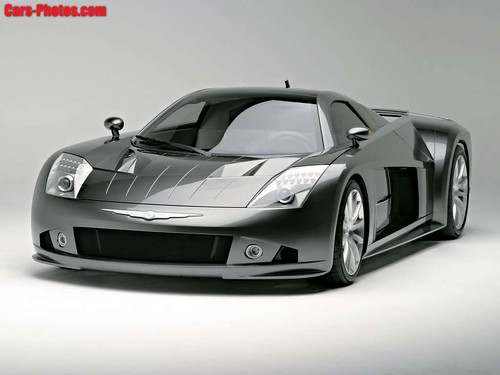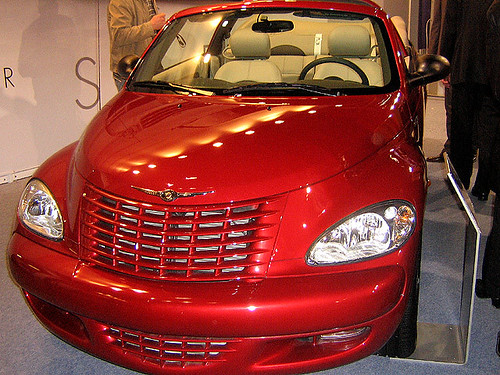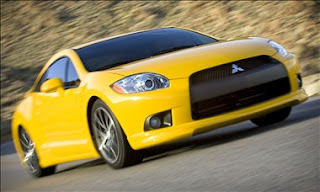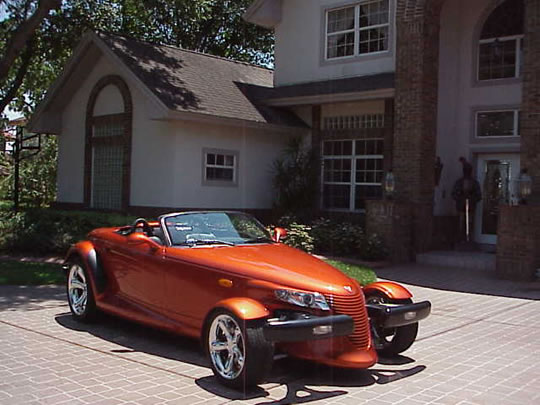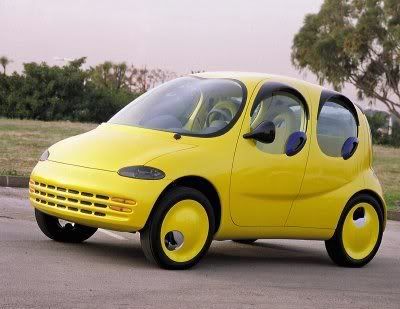
BelarusCars.com: Belarus Used car AC | Belarus Used car Acura | Belarus Used car Alfa Romeo | Belarus Used car American Motors | Belarus Used car Aston Martin | Belarus ...
Monday, September 8, 2008
Sunday, September 7, 2008
2010 Ferrari Millechili
A lightweight two-seater (2200 pounds or even less) loaded with Formula 1 technology. In many ways it will be a successor to the Enzo, but instead of adding power, Ferrari will add lightness. Don’t worry—the Millechili name won’t be making it to production.

F1 goodies make their way onto a road car. The technology and light weight will make this car spectacularly quick but also fuel efficient.
A derivative of the F430’s aluminum space frame on a slightly longer, 104.3-inch wheelbase. The mid-engine layout will carry a new V-10 of unknown displacement making upwards of 600 horsepower.
Active aerodynamics will manage airflow over the vehicle, thus reducing drag.
Source http://www.caranddriver.com

F1 goodies make their way onto a road car. The technology and light weight will make this car spectacularly quick but also fuel efficient.
A derivative of the F430’s aluminum space frame on a slightly longer, 104.3-inch wheelbase. The mid-engine layout will carry a new V-10 of unknown displacement making upwards of 600 horsepower.
Active aerodynamics will manage airflow over the vehicle, thus reducing drag.
Source http://www.caranddriver.com
Ferrari F430
The Ferrari F430 is Ferrari’s latest mid-engine V8-powered sports car, available as both a coupe and an open-top Spider, replacing the 360 Modena. The Ferrari 308 GTB was the first mid-engine V8 Ferrari and is one of the most popular Ferraris of all time. The 308 was followed by the 348 for 1990 and the F355 for 1995 before being replaced by the 360 Modena for 2000. The 360 Spider was added during the 2001 model year. The F430 continues the extensive use of aluminum for the chassis, body and suspension, which began with the 360 Modena. An optional braking system with carbon-ceramic discs will be available. The overall design of the F430 is very aerodynamic and includes elements used in racing, such as a flat underbody and a large diffuser that dominates the rear view of the car. The diffuser creates downforce and eliminates the need for a large rear wing, although the body does include a small lip at the center of the short rear deck. The design is much more aggressive than the 360 Modena, with sharper, chiseled lines and a less organic shape.
Technical Specs
Standard Engine 4.3L V8
Standard Transmission 6 Speed Manual
Cylinders 8Horse
power @ RPM 490@8500
Torque @ RPM 343@5250 (foot-lbs)
Saturday, September 6, 2008
Pontiac Solstice
The 2009 Pontiac Solstice adds a sleek new coupe with a fastback roofline, rear glass hatch, ducktail rear spoiler and a removable roof panel for open-air driving. The Solstice Coupe is offered in both base and GXP trim levels with the GXP powered by a 260-horsepower turbocharged Ecotec engine with direct injection that is rated at 28 mpg on the highway. Also for 2009, ABS, StabiliTrak electronic stability control a limited-slip differential are standard for all trim levels of the Solstice in both roadster and coupe form. The standard 18-inch wheels also sport a new look for 2009.
Technical Specs
Standard Engine 2.4L I4
Standard Transmission 5 Speed Manual
Cylinders 4Horse
power @ RPM 173@5800
Torque @ RPM 167@4500 (foot-lbs)


Mitsubishi Eclipse
Standard Engine 2.4L I4
Standard Transmission 5 Speed Manual
Cylinders 4Horse
power @ RPM 162@6000
Torque @ RPM 162@4000 (foot-lbs)
The Eclipse is Mitsubishi’s sporty coupe and convertible that receive updated styling for 2009 to tie it closer to the look of the high-performance Mitsubishi Lancer Evolution. The Eclipse Coupe was redesigned for 2006 and the Eclipse Spyder joined the lineup for 2007. The bold new styling was first revealed by the Eclipse Concept-E at the 2004 North American International Auto Show. With the bold new styling and powerful new engines, the new Mitsubishi Eclipse delivers a higher level of sophistication, and Mitsubishi aspires to impress a new group of buyers with this car as well.

The 2009 Mitsubishi Eclipse receives styling updates including a larger jet-fighter inspired grille evoking the new Lancer, and a new rear spoiler for the GT. The front and rear fascias are a single color for Eclipse ES and two-tone for the GT, which now features standard HID headlights and a new, more powerful sound from a dual exhaust system that raises engine output to 265 horsepower. The GT also receives standard Active Stability Control (ASC). Three new exterior colors are Maizen Blue pearl, Quick Silver metallic and Solar, a vibrant new yellow.
2008 Ferrari 430 Cars
Friday, September 5, 2008
The Jaguar Mark IV

The Jaguar Mark IV, pronounced mark four, was a saloon (sedan) car built by Jaguar from 1945 to 1949.
It was a relaunch of a pre World War II model made by SS Cars Ltd from 1936.
Before World War 2 the name Jaguar was the model name given to the complete range of cars built by SS Cars Ltd. The saloons were titled SS Jaguar 1½ litre, 2½ litre or 3½ litre. The two seater sports car was titled the SS Jaguar 100 2½ litre or 3½ litre.
After the war the company name was changed to Jaguar Cars Ltd. While the post war saloons were officially the Jaguar 1½ litre, 2½ litre and the 3½ Litre, the term 'Mark IV' was applied by the trade simply to seperate them from the officially named Mark V.
http://www.saloondata.com/ is an online site that keeps track of all the Classic Jaguar Saloon's still around.
You can also get a ton of info on the early Jags here:
http://www.jag-lovers.org/firstcats/mkiv.php3
Cadillac CTS
Technical Specs
Standard Engine 3.6L V6
Standard Transmission 6 Speed Manual
Cylinders 6Horse
power @ RPM 263@6400
Torque @ RPM 253@3100 (foot-lbs)
The CTS was the first salvo in what is now a totally revised Cadillac product lineup. At first glance, the 2008 CTS may not be as polarizing as the original, but closer examination reveals a dramatic exterior, and an interior that takes the CTS to a whole new level of refinement.
Power and HandlingMotivation for the rear-wheel-drive CTS is provided by a 263-horsepower 3.6-liter V6, an excellent engine that delivers the equivalent performance of the optional V6 in the previous-generation car. An optional 304-horsepower direct-injected 3.6-liter V6 ups the fun factor, but leaves room for a CTS-V to join the lineup. Either engine is available with an Aisin 6-speed manual, or Hydra-Matic 6L50 6-speed automatic transmission. A first for the CTS, all-wheel drive is now an option, but only on automatic models.
Both of the transmissions work well. The 6-speed manual is easy to shift, and precise enough to make it fun, while the 6-speed automatic delivers quick, smooth gear changes. The automatic has a very aggressive Sport mode, downshifting when the driver brakes for turns. This mode will also continue to hold the lower gear even when the driver backs off the throttle. It is probably too aggressive for most situations on the street, but the regular shift mode responds so quickly that it may be equivalent to the Sport mode in other vehicles.
Built with a two-inch-wider track than the previous version, the new CTS also has Bilstein shocks, high-precision ZF Servotronic steering and a revised suspension geometry developed with computer modeling and experience gained from the high-performance CTS-V. New 17- or 18-inch wheels are provided, depending on which of the three different suspension packages are ordered. The new chassis moves the CTS forward in terms of handling, putting it on par with European and Asian competitors. Don't take that statement lightly—that's where the racetrack comes in.
Track TunedMuch has been made of Cadillac's CTS development at the famed Nurburgring circuit in Germany. This renowned 13-mile road course is considered one of the most difficult in the world, and a more likely location for the latest Porsche or BMW prototype than a Cadillac.
The development work became obvious on the first section of twisty Northern Californian pavement we encountered. On our drive to Monterey, the CTS proved to be tight and responsive in corners and very well balanced overall. Carving through turns in a decisive manner, it provides precise steering and excellent side-to-side transitional response when lacing together a series of apexes.
Most of our road-time was in a CTS equipped with the FE2 suspension, the direct-injected engine, and a 6-speed automatic—a very nice package and probably what we would choose for the street. The FE2 suspension includes performance all-season tires—a good choice for everyday use. The standard 263-horsepower 3.6-liter V6 should not be overlooked, but since GM has placed only a $1000 premium on the direct-injected engine, it'll be hard to pass up.
As good as the CTS is on the road, surprisingly, it is even more impressive on the track. All of the track cars were equipped with the optional FE3 suspension with sticky Michelin Pilot Sport PS2 tires. The FE3 setup is intended for the serious enthusiast, and also includes load-leveling rear shocks. Even when pushed hard on the track, the FE3-equipped CTS remained balanced and controlled with minimal tendency to understeer, even allowing steering input mid-corner. The StabiliTrak stability control system is minimally intrusive, enabling deft drivers to provide some steering via the throttle.
Design Moves Forward AgainRedesigning the CTS posed a tricky challenge for GM designers. They needed to update a car that made a distinct impact with its aggressive original design. The goal was to make it more refined without losing that edge.
Gone are the harsh creases of the first-generation car; however, the new design is actually more aggressive due in part to the wider stance. The front is dominated by a larger, more vertical grille similar to that of the Cadillac Sixteen concept car. The grille is flanked by vertically stacked headlights, with fog lights and brake ducts to each side of the lower air intake.
While still crisp, the overall design is less blunt with a smoother, more sloping roofline. A shorter decklid tapers into an ever-so-slight boat-tail shape, and houses the signature vertical taillights. Chrome air extractors are added high on the front panels, and tie in with chrome window moldings and chrome exhaust tips.
Inside, the CTS delivers one of the most beautiful interiors ever from General Motors. A combination of luxury and sport, it's supported by flowing shapes and high-quality materials. The center stack dominates the design,flowing up and out to surround front-seat occupants, cockpit style.
To emphasize the attention to detail and luxury, the upper dash and door panel surfaces are hand-cut, then sewn and wrapped by craftsman. The exposed French stitching is also used for the seats and shifter boot to add to the fine detail. The console and center stack have a satin metallic finish, and all of the interior materials have a quality feel, addressing the area that was most criticized in the original CTS.
The door pulls and foot wells house subtle backlighting and clean, white, LED light pipes are recessed between the upper and lower instrument panel to add more indirect light. The analog instruments are housed in three binnacles surrounded by chrome accents, all surrounded by a single hood.
In the tech department, the new CTS offers an available Infotainment system with a touch-screen that rises up from the dash, a 40-gig hard drive, and state-of-the art navigation system with real-time traffic data via XM Satellite Radio.
The best news of all: The new CTS, with all its added performance and refinement, arrives with an MSRP starting at $32,990—$540 less than the 2007 CTS.
Acura TSX
Technical Specs
Standard Engine 2.4L I4
Standard Transmission 6 Speed Manual
Cylinders 4Horse
power @ RPM 205@7000
Torque @ RPM 164@4500 (foot-lbs)
The 2009 Acura TSX is powered by a new 201-horsepower 2.4-liter DOHC i-VETC inline 4-cylinder that now delivers more torque over a wider rpm range. New independent front and rear suspension with dual-stage dampers provides more agile handling and standard equipment includes a power glass moonroof, dual-zone automatic climate control, leather seats, a premium 7-speaker premium audio system and Bluetooth HandsFreeLink. The available Technology Package includes AcuraLink Satellite Communication System, Acura Navigation System with Voice Recognition, AcuraLink Real-time traffic, Traffic Rerouting, AcuraLink weather and a 415-watt, 10-speaker Acura/ELS Premium Surround Sound System with DVD-Audio designed by Grammy Award winning producer/engineer Elliot Scheiner.
Jaguar XJ Series
Technical Specs
Standard Engine 4.2L V8
Standard Transmission 6 Speed Automatic
Cylinders 8Horse
power @ RPM 300@6000
Torque @ RPM 310@4100 (foot-lbs)
The XJ Series is the flagship of Jaguar’s line of premium luxury sedans. All of the XJ sedans are descendants of the classic S-type Jaguars of the late '50s and early '60s, with the first XJ sedan debuting in 1968. Jaguar buyers have benefited from Ford's acquisition of Jaguar several years ago that resulted in increased quality and reliability.The 2008 Jaguar XJ Series gets a redesigned look with a revised front-end, new side power vents, rear aero spoiler, full-width chrome “signature blade” and new rear bumper. Revised with an all-new seat design, the interior also receives standard heated front seats, increased rear leg and foot room thanks to redesigned front seat backs. New 19-inch Polaris, Vela and Carelia alloy wheels are available and three new exteriors have been added. An upgraded Bluetooth system allows up to five phones to be paired to the in-car telephone system.
Thursday, September 4, 2008
Mazda Mazda6
Technical Specs
Standard Engine 2.3L I4
Standard Transmission 5 Speed Manual
Cylinders 4Horse
power @ RPM 156@6500
Torque @ RPM 154@4000 (foot-lbs)
The 2009 Mazda Mazda6 is Mazda’s sporty midsize sedan that is all-new for 2009. Built specifically for the North American market, the bold design incorporates design cues from the CX-7 including the aggressive front fender lines and the fast roofline. Tthe 2009 Mazda6 is larger than its predecessor with a 4.5-inch longer wheelbase, wider front and rear tracks, 2.3-inch increase in width and a total gain of 6.1 inches in overall length. Inside the Mazda6 is larger in all significant dimensions and the trunk volume increases by 10 percent. The Mazda6 replaced both the 626 and the Millenia in the Mazda lineup for 2003. The 626 first arrived in 1979 and in 1988 it became one of the first Japanese-brand cars to be built in the U.S.
The all-new 2009 Mazda Mazda6 is offered in two versions, the Mazda6 i powered by a 170-horsepower 2.5-liter 4-cylinder and the Mazda6 s powered by a 272-horsepower 3.7-liter V6 engine. A new 6-speed manual transmission is standard for Mazda6 i, Touring and Grand Touring trim levels include new advanced keyless entry that automatically unlocks the doors when approaching the Mazda6 with the remote and enables push-button starting without the use of a key. Available options include Blind Spot Monitoring System, rain sensing wipers and Bluetooth connectivity for audio and phone.
Subscribe to:
Comments (Atom)
Popular Posts
-
In a change from all the high dollar exotic cars I usually feature here, this is a high dollar exotic Chevrolet. The Chevrolet Corvette C6 Z...
-
Buying car insurance for the first time is a scary situation. After all, you are buying a contract, and any sort of binding contract makes u...
-
Batmobile Sells For 120k The iconic Batmobile from the cult 1960s show Batman has been sold for £120000 at auction in London. The Lincoln F...
-
Warrnambool Standard : "HORSEPOWER rumbled Port Fairy at the weekend when South West Hot Rod Club's annual show roared into town. V...
-
Jaguar E- Type, Low Drag Coupé (1962) After the introduction of the E-type, Jaguar wanted to investigate the possibility of building a car m...
-
Second generation models increased engine power, improved suspension, and reduced braking distances; the 1996 to 2002 Viper GTS had a 450 b...
-
The Dodge Viper is the most powerful production car made by Dodge. Production of the two seat sports car, the Dodge Viper, began at New Mack...
-
Did you know that the Lexus was mass-produced by Toyota, the Japanese Motor Company that makes Corollas and Highlanders? Well they do and th...









